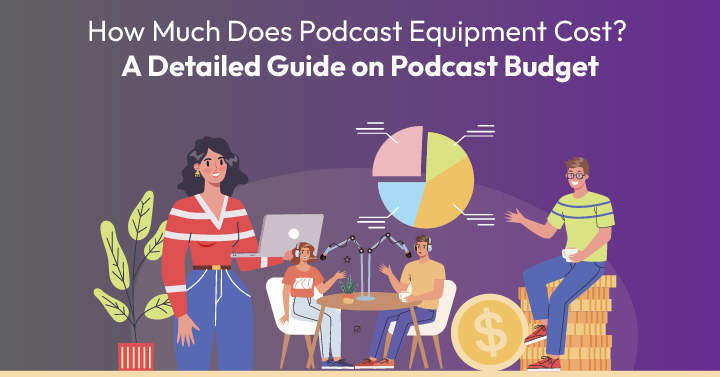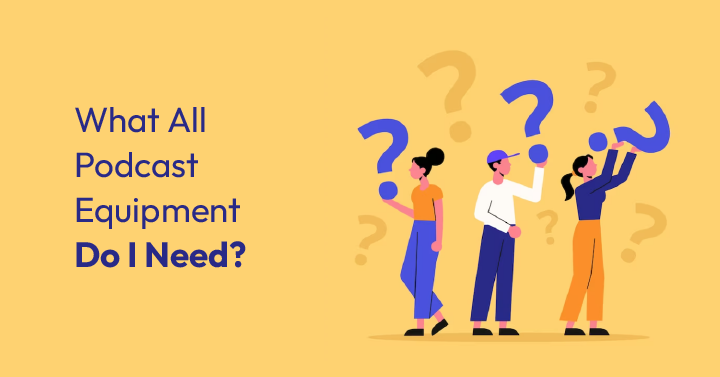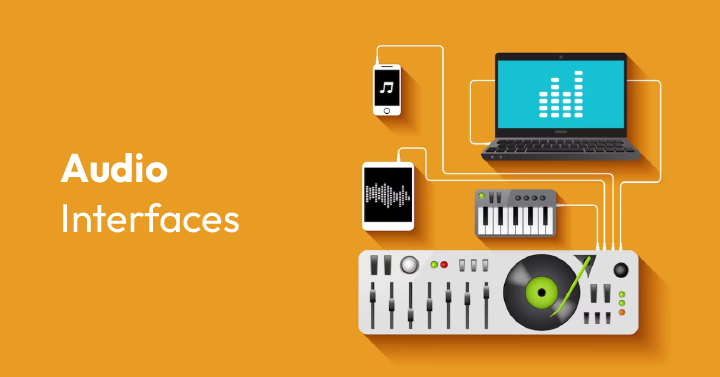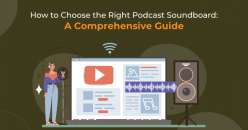
Ready to start your own podcast but wondering how much it will cost you? Well, the good news is that podcasting doesn’t have to break the bank. With the right equipment and a solid budget plan, you can produce high-quality content without emptying your wallet. But how much does podcast equipment cost, really? And what should you include in your budget to ensure you have everything you need?
In this detailed guide, we’ll take a deep dive into podcast budgeting and break down the costs of everything from microphones to hosting services. By the end of this post, you’ll be ready to launch your podcast and keep your budget intact.
1. Definition of a Podcast Budget
A podcast budge is essential to look at when trying to determine how much does podcast equipment cost. It refers to the amount of money allocated for the creation, production, and distribution of a podcast. This budget typically includes all expenses related to the podcast, such as equipment, software, hosting, editing, and marketing.
Creating a podcast requires a significant amount of effort, time, and money. A podcast budget helps to ensure that all necessary expenses are accounted for and that the podcast can be produced and distributed without running out of funds.
2. Importance of Budgeting for Podcasts
- Helps to control costs
Budgeting ensures you have a clear understanding of the expenses required to produce a podcast. It helps to identify the necessary expenses and allocate funds accordingly. By tracking the expenses, you can control the costs and avoid overspending
- Ensures sustainability
Podcasts require regular episodes to build and maintain an audience. Budgeting helps to ensure the sustainability of the podcast by allocating funds for regular production, hosting, and distribution.
- Improves production quality
A budget enables you to invest in better-quality equipment and production tools. By allocating funds for the purchase or rental of better equipment, you can improve the production quality of the podcast.
- Enables marketing efforts
Podcast marketing is essential for building an audience. A budget can help allocate funds to promote the podcast through various marketing channels like social media, email marketing, and paid advertising.
- Helps in monetizing the podcast
Budgeting is essential for those who plan to monetize their podcast. By understanding the costs and the potential revenue streams, you can create a sustainable business model for your podcast.
3. What All Podcast Equipment Do I Need?

3.1 Microphones
There are different types of microphones that are suitable for podcasting, each with its own set of advantages and disadvantages. Here are some of the most common types of microphones for podcasting:
- Dynamic Microphones
Dynamic microphones are a popular choice for podcasting because they are relatively affordable and offer good sound quality. They use a diaphragm that vibrates in response to sound waves, generating an electrical signal.
Dynamic microphones are less sensitive than condenser microphones, which means they are less likely to pick up the background noise. Also, they have a low self-noise, which means they produce little to no hiss or hum when recording. They are commonly used in podcasting, live performances, and studio recording due to their durability, affordability, and versatility.
Our Top Picks –
| Microphone | Price | Connection Type |
| Shure SM58 | $99 | XLR |
| Samson Q9U | $99 | XLR + USB |
| Rode Procaster | $229 | XLR |
| Shure MV7 | $249 | XLR + USB |
| Neumann BCM 705 | $700-$730 | XLR |
- Condenser Microphones
Condenser microphones are more sensitive than dynamic microphones and offer a wider frequency response. They are a popular choice for studio recordings and offer high-quality sound. However, they are also more expensive than dynamic microphones and require a power source, such as phantom power.
Condenser microphones have a high-frequency response, which means they can capture the higher frequencies of instruments and vocals with more accuracy and detail.They are more accurate and have a flatter frequency response, which means they can capture a wider range of frequencies and provide a more natural sound.
Our Top Picks –
| Microphone | Price | Connection Type |
| Rode NT1 | $199 | XLR |
| Stellar X2 | $199 | XLR |
| Neumann TLM 102 | $729 | XLR |
| AKG P220 | $159 | 3-pin XLR |
| Blue Yeti X | $169 | XLR + USB |
3.2 Audio Interfaces

There are a variety of audio interfaces that can work well for podcasting, depending on your specific needs and budget. Here are some common types of audio interfaces that are popular for podcasting:
- USB Audio Interfaces
These are simple, affordable, and easy-to-use interfaces that connect directly to your computer via USB. They often have multiple inputs for microphones, as well as built-in preamps and EQ controls. Some podcasters prefer to use a mixer with a built-in USB or Firewire interface to handle their audio.
Audio interfaces with mixers offer greater control over levels and EQ, as well as the ability to mix in additional audio sources like music or sound effects.
Our Top Picks –
| USB Audio Interface | Price |
| Focusrite – Vocaster | $243.99 |
| RODE Single-Channel audio interface | $129 |
| Focusrite Scarlett 2i2 3rd Gen | $249.99 |
| Antelope Audio Zen Go | $495 – $649 |
- Thunderbolt Audio Interfaces
Thunderbolt interfaces can be more expensive than USB interfaces, but they typically offer higher-quality sound and more advanced features. These interfaces are known for their speed and low latency, which can be important for live podcasting or recording with multiple microphones.
These devices are a good option for podcasters who want to record on-the-go, or who prefer not to use a computer for recording. They typically include built-in microphones, as well as inputs for external microphones or instruments.
Our Top Picks –
| Thunderbolt Audio Interfaces | Price |
| Universal Audio Apollo Twin X DUO Heritage Edition | $973 |
| PreSonus Quantum 26×32 Thunderbolt 2 Audio Interface | $999.99 |
| MOTU 828X | $849 |
| RME Fireface UFX+ | $2,999 |
| Antelope Orion Studio Synergy Core | $2,795 |
3.3 Headphones
There are several types of headphones that can be suitable for podcasting, depending on your specific needs and preferences.
- Closed-back Headphones
Closed-back headphones are a type of headphones that are designed with sealed ear cups to block out external noise and prevent sound leakage. The ear cups are typically made of hard plastic or metal and are designed to enclose the ears fully. This design creates a seal around the ear, which helps to prevent sound from escaping and minimizes the amount of external noise that can enter the headphones.
These are designed to block out external sound and provide a clear and isolated listening experience. They are good for recording in noisy environments or for podcasters who prefer not to hear background noise while recording.
Our Top Picks –
| Closed-back Headphones | Price |
| Audio Technica ATH-m20x | $70 |
| Sony MDR7506/1 | $79.99 |
| Sennheiser HD-25 | $149 |
| Shure SRH940 | $299 |
- Open-back Headphones
These headphones are designed to allow some external sound, which can provide a more natural and spacious sound. They are good for podcasters who prefer a more natural sound or need to be aware of their surroundings while recording. Examples include the Sennheiser HD 600 and the Beyerdynamic DT 990 Pro.
Our Top Picks –
| Open-back Headphones | Price |
| Sennheiser HD 660S | $299 |
| HiFiMan Arya | $1299 |
| HiFiMan Edition XS | $499 |
| Philips Fidelio X2HR | $126 |
| Philips SHP9500 | $74 |
- In-ear Monitors
These small earbuds sit inside the ear canal and provide a more discreet and portable listening experience. They are good for podcasters who need to move around while recording or for podcasters who prefer a more discreet look. Examples include the Shure SE215 and the Westone W20.
Our Top Picks –
| In-ear Monitors | Price |
| Shure SE846Pro | $799 |
| Audio Technica ATH-E70 | $499-$550 |
| Sennheiser IE 40 Pro | $16.95 |
| Mackie MP-220 | $149 |
| InEar ProPhile-8 | $1,562 |
3.4 Recording/Editing Equipment
There are many different software options for recording and editing podcasts, ranging from simple, user-friendly programs to more advanced and feature-rich options.
- Recording Software
To record your podcast, you will need software that can capture your microphone input and save it as an audio file.
Our Top Picks –
| Recording Software | Subscription Cost | Compatibility |
| Restream | $16/per for Standard Plan | Browser |
| Adobe Audition | $20.99 per month for desktop | Windows, MacOS |
| GarageBand | Free | MacOS, iOS |
| LogicPro | $199.99 | MacOS |
| Audacity | Free | Windows, Linux, MacOS |
- Editing Software
After recording your podcast, you will need software that allows you to edit and fine-tune the audio. This may include cutting out mistakes, adding music or sound effects, and adjusting levels and EQ.
Our Top Picks –
| Editing Software | Subscription Cost | Compatibility |
| Alitu | $28/month | Browser-based |
| Reaper | $225 for commercial license | Windows, Linux, and MacOS |
| Fission | $29/month | MacOS |
| TwisterWave | Start at $79.90/month | iOS, Browser, MacOS |
| WaveLab 10 | Starts at $40/month | Windows, MacOS |
3.5 Additional Accessories

There are several accessories that can help improve the quality of your podcast and make the podcasting process more efficient.
- Pop Filters
Pop filters are used to reduce or eliminate popping sounds that can occur when recording vocals, particularly when pronouncing plosives like “p” and “b”. They are typically placed in front of the microphone and help to diffuse the airflow and reduce the impact of these sounds.
Our Top Picks –
| Pop Filter | Price |
| Auray PFSS-55 Pop Filter | $22 |
| Nady MPF-6 | $32.60 |
| On-Stage ASFSS6-GB | $34.95 |
| Shure PS-6 Popper Stopper | $34.99 |
- Shock Mounts
Shock mounts are used to isolate the microphone from vibrations and shock that can occur from things like bumping the desk or moving around. They help to reduce handling noise and ensure a clean, clear recording.
Our Recommendation –
| Shock Mounts | Price |
| Rycote Invision USM Shock Mount | $79 |
| Rode PSM1 Shock Mount | $39 |
| Sabra Som SSM-1 Universal Shock Mount | $49.99 |
| Auphonix Silver Shock Mount | $11.61 |
- Cables
Cables are an essential component of any podcast setup, as they connect your microphone and audio interface to your recording device. Make sure to choose high-quality cables that are compatible with your equipment and provide adequate shielding to prevent interference. Examples include the Mogami Gold Studio XLR cable and the Hosa Technology Stereo Mini to XLR cable.
Our Recommendation –
| Cables | Price | Connection Type |
| Gearlux XLR Microphone Cable | $13.99 | XLR |
| Monster Classic Microphone Cable | $29.99 | XLR |
- Adapters
Adapters can be used to connect different types of equipment or cables. For example, you may need an XLR to the 1/4-inch adapter to connect your microphone to a mixer, or a USB adapter to connect your audio interface to your computer. Examples include the Hosa Technology XLR Female to 1/4″ TS adapter and the UGREEN USB Audio Adapter.
The price of a basic podcast adapter that allows you to connect a microphone to your computer or mobile device can range from $20 to $50.
4. Final Thoughts on How Much Does Podcast Equipment Cost
The answer to how much does podcast equipment cost can vary widely depending on your specific needs and preferences. Here is a rough estimate of the cost for some of the essential equipment:
- Microphone: You can find a basic dynamic microphone for under $50, but higher-end condenser microphones can cost several hundred dollars or more.
- Headphones: Basic headphones can cost less than $20, but higher-end headphones designed for studio use can cost several hundred dollars.
- Audio Interface: A basic USB audio interface can cost between $50 and $150, while a higher-end interface can cost several hundred dollars or more.
- Recording and Editing Software: There are free options like Audacity, but professional-grade editing software like Adobe Audition or Pro Tools can cost several hundred dollars annually.
- Pop Filters and Shock Mounts: Pop filters and shock mounts can cost between $20 and $100 each, depending on the brand and quality.
- Cables and Adapters: The cost of cables and adapters can vary widely depending on the type and length needed. Expect to pay between $10 and $50 for a good-quality cable and adapter.
In total, a basic podcast setup can cost less than $200-$250, while a more advanced setup can cost several thousand dollars.
5. FAQS
- How Much Does a Podcast Mic Setup Cost?
The cost of a podcast mic setup can vary depending on the type and quality of microphone you choose. A basic USB mic, such as the Blue Snowball or the Samson Meteor, can cost between $50 and $100. Whereas a mid-range XLR microphone, such as the Audio-Technica AT2020 or the Shure SM58, can cost between $100 and $300. If you are looking for a high-end XLR mic, such as the Electro-Voice RE20 or the Shure SM7B, it can cost between $300 and $500 or more.
- Do You Need Expensive Equipment to Podcast?
You don’t necessarily need expensive equipment to start a podcast. While high-quality equipment can certainly enhance the sound quality of your podcast, it’s possible to create a successful and engaging podcast with budget-friendly equipment.



